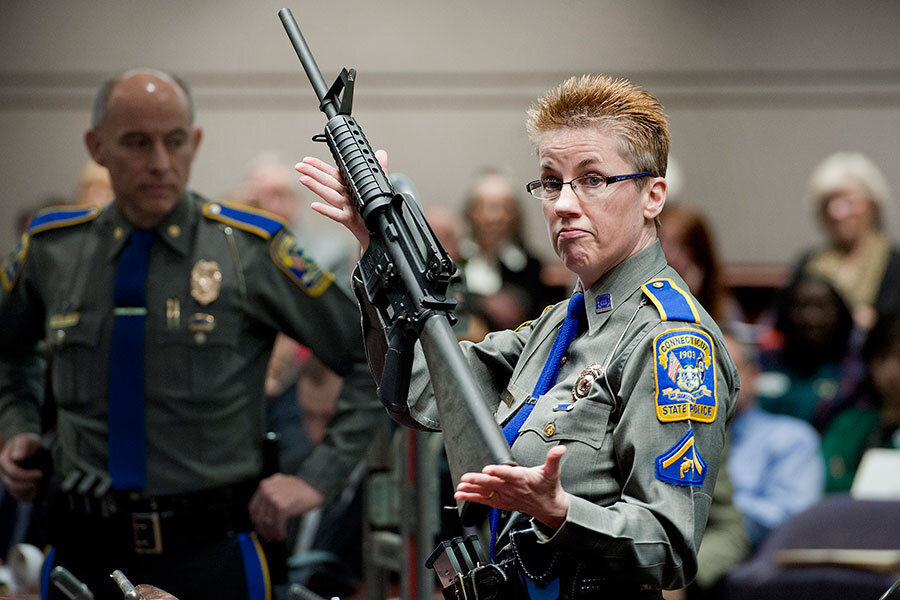Why a Colorado school district is buying 10 semiautomatic rifles
Loading...
It is an eye-opening line item in the budget for the Douglas County School District in Colorado: $12,300 for 10 semiautomatic long rifles.
In the post-Sandy Hook era, however, it is not a wholly unprecedented request.
Rural school districts, in particular, looked at the military-style weapon used in the Newtown, Conn., school shooting as a game changer. With schools sometimes situated miles from the nearest law enforcement, how could such districts adequately prepare for such a threat?
They could make sure security officials on scene weren’t outgunned, at least.
Douglas County’s announcement this week was just the latest point in a three-year trend line. That trend is limited. In the wake of the Sandy Hook massacre, for example, the Pentagon sent anti-attack gear – including dozens of M-16 rifles – to 26 school districts. Some districts returned them.
Indeed, the decision to arm up is not taken lightly. The Cherry Creek School District, also in Colorado, is considering buying high-powered rifles for school security, but “it’s a very difficult conversation,” says spokeswoman Tustin Amole.
“The option is out there,” she says. “Is it the right answer? We don’t know.”
Still, that conversation, combined with the actions of Douglas County, point to a shift in thinking about security. Though schools are, statistically speaking, still enormously safe, the fear of a military-style attack is moving some rural districts to action.
“For word to get out [about the long-rifle purchases] shows a changing of the landscape of school safety and security across the country, in that the caliber and capacity of the weaponry is increasing to match that of the perpetrators,” says Ronald Stephens, executive director of the National School Safety Center, which certifies thousands of school safety officers across the country.
In Douglas County’s case, the rifles will be used by eight of its school security officers. In the Cherry Creek proposal, the rifles would be stored safely on campus for responding police officers to utilize if needed.
The need for such steps comes down to a matter of perception. The number of mass shootings annually more than doubled in the six-year period from 2007-2013 compared with 2000-2006, according to the Federal Bureau of Investigation. One quarter of those mass shootings took place in schools.
But “children are almost 100 times more likely to be murdered outside of school than at school, which makes massive expenditures for school building security seem like a misallocation of tax dollars,” writes Dewey Cornell, a forensic clinical psychologist at the University of Virginia in The Washington Post.
Some schools agree. When Jill Poe took over as police chief of the Baldwin Park (Calif.) Unified School District in 2014, she spotted three Pentagon surplus M-16 rifles in a storage locker – and sent them back.
“They have never been used in the field and they will never be used in the field,” Chief Poe told The San Jose Mercury News.
Likewise, in 2014, the Los Angeles Unified School District police department returned three surplus grenade launchers to the Pentagon, saying they weren’t operationally necessary.
Not many schools are going to argue for grenade-launchers. But the call on high-powered rifles is not as easy, some officials say.
“You look at the realities of the world we live in versus what is safe and what makes sense, finding that fine line is not an easy task,” says Ms. Amole, the Cherry Creek spokeswoman.
Others say heavier weaponry can help solve the problems posed by military-style attacks.
"The decision to buy these guns were part of a proactive approach to figure out how to best protect students and staff in our district that sprawls across approximately 900 square miles," Douglas County schools spokeswoman Paula Hans told ABC News.
The discussion about heavy weapons is part of a broader debate over guns on campuses. Eighteen states allow gun-certified teachers to carry handguns at work. Nine states allow college students to carry weapons defensively on campus.
A January CBS News/New York Times poll found that 38 percent of Americans want to see teachers packing heat.
The genesis of the armed school movement can be traced back to the 1990s, particularly an incident where a vice principal armed with his personal .45 caliber handgun helped stop Luke Woodham, who had killed two people and injured seven in a trench-coat attack on Pearl High School in a Jackson, Miss., suburb.
But critics say long rifles at schools could compound risks to kids. “One accident in close quarters with these things could be devastating, not only to predators but to the students themselves," Dan Montgomery, the former police chief of Westminster, Colo., told The Denver Post.
Whether districts should buy long rifles “really depends where you are,” suggests Mr. Stephens, the school security expert. “I know of a school down on the [US-Mexico] border where they have a little gun tower with an armed officer standing guard. My advice to school officials is: Do everything you can, knowing you can’t do everything.”






